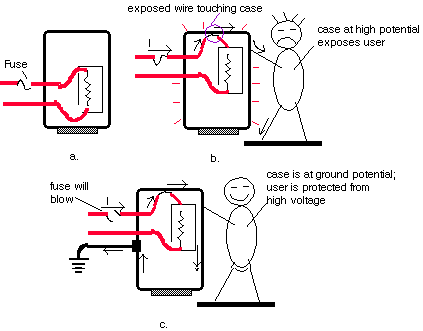Lab Safety
Acquaint yourself with the location of the following safety items within
the lab.
-
Fire extinguisher
-
First aid kit
-
Telephone and emergency numbers : Make sure that you have handy emergency
phone numbers to call for assistance if necessary. The number for
emergencies is on campus is 511. (No need to dial 8 for this number).
If any safety questions arise, consult the lab instructor or staff for
guidance and instructions.
Observing proper safety precautions is important when working in
the laboratory to prevent harm to yourself or others. The most common hazard
is the electric shock which can be fatal if one is not careful.
Electric shock
Shock is caused by passing an electric current through the human body.
The severity depends mainly on the amount of current and is less function
of the applied voltage. The threshold of electric shock is about 1 mA which
usually gives an unpleasant tingling. For currents above 10 mA, severe
muscle pain occurs and the victim can't let go of the conductor due to
muscle spasm. Current between 100 mA and 200 mA (60 Hz AC) causes ventricular
fibrillation of the heart and is most likely to be lethal.
What is the voltage required for a fatal current to flow? This depends
on the skin resistance. Wet skin can have a resistance as low as 150 Ohm
and dry skin may have a resistance of 15 kohm. Arms and legs have a resistance
of about 100 Ohm and the trunk 200 Ohm. This implies that 110 V can cause
about 160 mA to flow in the body if the skin is wet and thus be fatal.
In addition skin resistance falls quickly at the point of contact, so it
is important to break the contact as quickly as possible to prevent the
current from rising to lethal levels.
Equipment grounding
Electric instruments and appliances have equipment cases that are electrically
insulated from the wires that carry the power. The isolation is provided
by the insulation of the wires as shown in the figure a below. However,
if the wire insulation gets damaged and makes contact to the case, the
case will be at the high voltage supplied by the wires. If the user touches
the instrument he or she will feel the high voltage. If, while standing
on a wet floor, a user simultaneously comes in contact with the instrument
case and a pipe or faucet connected to ground, a sizable current can flow
through him or her, as shown in Figure b. However, if the case is connected
to the ground by use of a third (ground) wire, the current will flow from
the hot wire directly to the ground and bypass the user as illustrated
in figure c.
 Equipment with a three wire cord is thus much safer to use. The ground
wire (3rd wire) which is connected to metal case, is also connected to
the earth ground (usually a pipe or bar in the ground) through the wall
plug outlet.
Equipment with a three wire cord is thus much safer to use. The ground
wire (3rd wire) which is connected to metal case, is also connected to
the earth ground (usually a pipe or bar in the ground) through the wall
plug outlet.
Safety Precautions
-
-Do not work alone while working with high voltages or if you are using
electrically operated machinary like a drill.
-
-Never leave high voltages on when you are not present.
-
-Keep one hand in your pocket when probing high voltage circuits or discharging
capacitors.
-
-Make sure all high voltage connections are adequately taped or otherwise
insulated to prevent accidental contact by you or neighboring students.
-
-After switching power off, discharge any capacitors that were in
the circuit. Do not trust supposedly discharged capacitors. Certain types
of capacitors can build up a residual charge after being discharged.
Use a shorting bar across the capacitor, and keep it connected until ready
for use.
-
-If you use electrolytic capacitors, do not
-
put excessive voltage across them
-
put ac across them
-
connect them in reverse polarity
-
-Take extreme care using tools that can cause short circuits if accidental
contact is made to other circuit elements. Only tools with insulated handles
should be used.
-
-If a person comes in contact with a high voltage, immediately shut off
power. Do not attempt to remove a person in contact with a high voltage
unless you are insulated from them.
-
-In the event of an electrical fire do not use water. The lab fire extinguishers
are specifically charged for electrical fires. Vacate the lab and close
the door. Do not breath toxic smoke or fumes. Ring the fire alarm, if one
is available.
-
-Check wire current carrying capacity if you will be using high currents.
The lab power wiring can only handle 15 Amperes continuously.
-
-Make sure your leads are rated to withstand the voltages you are using.
This includes instrument leads. Common wire insulation is rated for
600 Volts.
-
-Avoid simultaneous touching of any metal chassis used as an enclosure
for your circuits and any pipes in the laboratory that may make contact
with the earth, such as a water pipe. Use a floating voltmeter to measure
the voltage from ground to the chassis to see if a hazardous potential
difference exists.
-
-Make sure that the lab instruments are at ground potential by using the
ground terminal supplied on the instrument.
Back to ESE200 Lab page

